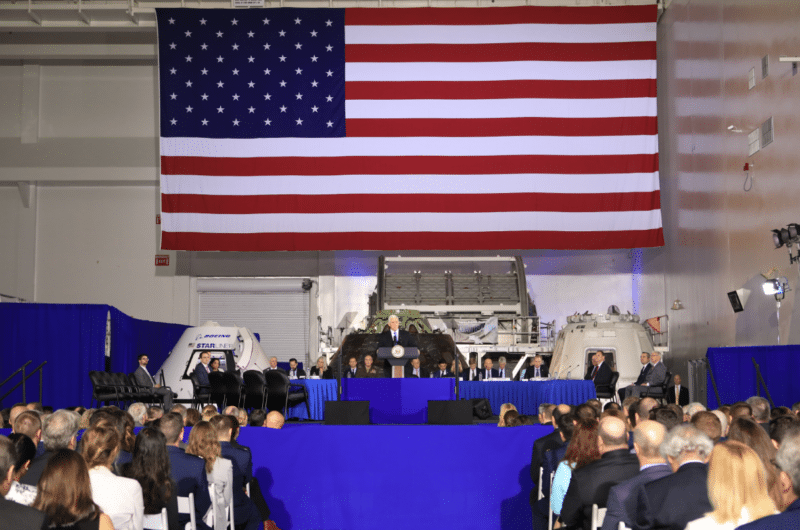Latest News

Vice President Pence Hosts National Space Council at NASA’s Kennedy Space Center. Photo: NASA.
When it comes to U.S. commercial, civil and military satellite communication services, three seemingly interrelated areas — innovation, spectrum certainty, and sustainable space operations — are critical to the industry’s future. At the recent National Space Council (NSC) meeting chaired by Vice President Mike Pence at NASA’s Kennedy Space Center in Florida, I was honored to join leaders in the civil, commercial, and national security sectors to describe our industry’s interests to the NSC in my role at the Satellite Industry Association (SIA). I’m happy to report that council members were very interested in what I outlined as priorities.
In my testimony, I reiterated the important contributions the satellite industry is making to our economy, to the military, and in American innovation and growth. I stressed the importance of sustaining and meeting the growing demand for satellite services and how these services depend upon our ability to continue to have regulatory certainty regarding allocated spectrum — spectrum which is used for so many diverse satellite services including how we map, navigate, and see our world via the Global Positioning System (GPS). I highlighted that satcom enables Earth Observation (EO) and directs how we produce food and energy; it promotes how we conduct banking, predict the weather, and ensure national security.
Satcom permits the surveying of damage in the aftermath of natural disasters, not just for emergency managers, but also for average citizens across the globe. For example, after the three-storm punch in the fall of 2017 from hurricanes Harvey, Maria and Irma, citizens in impacted areas were able to zoom in on aerial maps available via satellite to see whether their properties were flooded, had intact roofs, or contained downed powerlines, tree blockages, debris destruction and other hazards. This armed them with vital information to assess whether it was safe to return to their properties and assisted them concerning the plans of action to take.
I discussed the ubiquity of satellite coverage and the critical access it provides to consumers — be they in densely populated urban areas, rural areas, or in remote areas that are otherwise unreachable by terrestrial communications. Satellites provide telecommunications services to U.S. citizens, from Olympic Games TV viewers, to commercial airline passengers, and to scientists at the South Pole.
I emphasized that commercial satellite operators have invested tens of billions of dollars in the construction and deployment of High Throughput Satellites (HTS) that rely on frequency re-use and spot beam technology to increase output factors more than 20 times that of traditional satellites. When the Internet of Things (IOT) and vastly expanded mobile commerce materialize, the industry is poised for sharp growth within the U.S. This economic growth represents millions of American jobs, supported by the satellite industry. Setting the path for next-generation satellites such as HTS is paramount for both the industry and the military, as satellites enable our collective safety and national security.
Commercial satellite capabilities also enhance our military’s ability to project power in the air, on land, and at sea. Satellites support Remotely Piloted Aircraft (RPA), other advanced weapons systems such as the F-35, and U.S. Navy warships. These capabilities include Intelligence, Surveillance and Reconnaissance (ISR) satellites that allow us to perceive global threats from missiles, terrorism and activities of enemy combatants and potential adversaries. Satellite delivery of data is well-recognized as crucial for the military as well as for many other key government applications.
The assurance of regulatory certainty regarding spectrum availability is critical to ensuring that investments in new satellite systems are not wasted and that these important services can continue to be provided. I emphasized the need to have our U.S. satellite industry efforts reinforced at the upcoming World Radiocommunication Conference 2019 (WRC 19).
I also noted that with so many existing services, as well as new ones on the horizon, it’s our responsibility to protect space as a shared natural resource and preserve its availability for use by future generations. This means space safety and safeguarding against orbital debris must be on the agenda for both the private sector and for our government working at the domestic and international levels. Together we must develop and apply thoughtful and common-sense rules for how we can continue innovating and developing life-changing services while also acting responsibly.
In the NSC Q&A session, I addressed the need for federal procurement reform. Obtaining satcom services is a long process, and the military, as a large customer of the industry, needs to be able to acquire satellite services more quickly in the interest of national security.
In closing, I asked the government’s backing for the advancement of the satellite industry in three critical ways:
- First, create a regulatory environment that fosters the continued innovation and leadership of U.S. satellite companies by prioritizing regulatory certainty with respect to spectrum allocation.
- Second, support access to additional spectrum to promote the continued growth of the industry; and
- Third, ensure a sustainable space environment.
Implementing an effective sustainability strategy for the satellite industry worldwide is not an easy task. At WRC 19, leadership from around the world will gather to make impactful decisions to shape the way forward for satellite communications. I will be there to help inform and influence the U.S. path as we push forward and upward.
National Space Council
The National Space Council advises the president regarding national space policy and strategy and reviews the nation’s long-range goals for space activities. Review the full meeting:

Tom Stroup is president of the Satellite Industry Association (SIA), which represents the leading satellite operators, manufacturers, launch providers and ground equipment suppliers which serve commercial, civil and military markets. He serves as the trade association’s lead advocate for regulatory and policy issues of critical importance to SIA’s membership, including spectrum and licensing issues, defense and public safety matters, and export control and international trade issues.
Get the latest Via Satellite news!
Subscribe Now